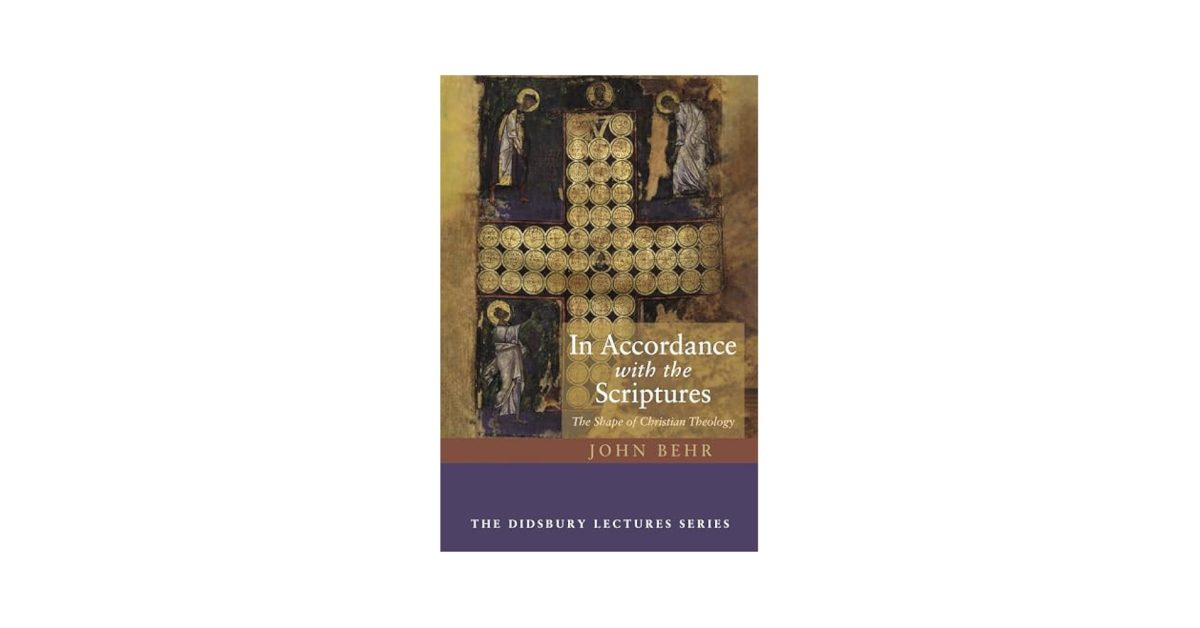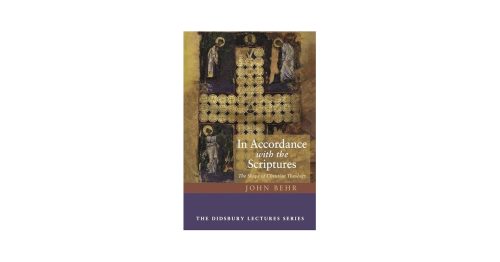

IN ACCORDANCE WITH THE SCRIPTURES: The Shape of Christian Theology. (The Didsbury Lectures Series). By John Behr. Eugene, OR: Cascade Books, 2025. Xvi + 146 pages.
When we do theology, many people start with the “Bible.” Since it is considered the primary source for doing theology, it seems prudent to define what makes the Bible the authoritative source for doing theology. This is especially true for Protestants, and even more so for those who embrace a restorationist view of the Christian faith. Once we establish the authority of the Bible (as an authoritative book), we can begin to address the various doctrines, perhaps starting with God’s nature or perhaps creation, and then move from there to the consummation, with Jesus placed somewhere in the middle. But what if such a starting point is too constrictive? Instead of thinking of the Bible as a book with chapters that need to be read from the beginning to the end, perhaps we should think in terms of the Scriptures, which would allow for a broader understanding of what constitutes an authority for doing theology. If we moved from the Bible to the Scriptures, what might Christian theology look like? These are the kinds of questions that John Behr takes up in his book In Accordance with the Scriptures: The Shape of Christian Theology.

Robert D. Cornwall
The author of In Accordance with the Scriptures, John Behr, is Regius Professor of Humanity at Aberdeen University (Scotland). He formerly served as professor and dean at St. Vladimir’s Seminary. Behr identifies as Eastern Orthodox, and it is from that perspective that he offers this look at “The Shape of Christian Theology.” The book itself is based on Behr’s 2024 Didsbury Lectures, which have been sponsored by Nazarene Theological College (Manchester, UK) since 1979 (F.F. Bruce delivered the first set of lectures).
In recent years, many Western Christians, including myself, have begun to look to Eastern Orthodoxy to broaden and deepen their theological understandings. Some have converted, but others (me included) have found Orthodox theologians such as Sergius Bulgakov, Vladimir Lossky, and Alexander Schmemann, to be insightful and worth consulting. John Behr is a younger Orthodox theologian who studied under Kallistos Ware at Oxford, and to whom many have begun to turn for insight and guidance.
In Accordance with the Scriptures is not a lengthy book, but it is dense at points. It challenges the way many Christians, especially evangelical Protestants, view the Bible by pointing us to other ways of viewing what we know to be the Bible. He has chosen the term scriptures instead of the Bible for a reason. By choosing the term “scriptures,” he allows for the elements we find in the “Bible” to be engaged in their diversity rather than placed in an interpretive straitjacket. What he does here is propose a theological center, which is Christological in nature.
Behr begins this brief study in Chapter 1, which he titles “Figuring Scripture.” In this chapter, he seeks to deconstruct the traditional view of Christian theology that is rooted in a narrative pattern that follows a trajectory of Creation–Fall–Salvation History– Incarnation–Crucifixion–Resurrection–Ascension–Pentecost, culminating in the Second Coming. The problem with this pattern, according to Behr, is that even though it is supported by a liturgical calendar, no council ever decided on an official biblical canon. As he reminds us, the first full listing of what is now the New Testament doesn’t emerge until Athanasius provided his list in the 4th century. Therefore, if we are to better understand Christian theology, he suggests we should unmoor our theology from the current narrative pattern. That is, instead of looking at the “Bible” as a book for guidance, we should look to the scriptures for guidance. By scripture, he envisions a “field of literature” rather than a bound book.
What Behr proposes seems to be a complicated scenario, but it is an intriguing one. In laying out his vision for doing theology, he draws on Irenaeus’s concept of recapitulation, such that the New Testament serves as a recapitulation of what we encounter in the scriptures. In essence, he is calling for Christians to read the Old Testament in light of Christ, something early Christian theologians did. As we think of this in terms of doing theology, he places the contemporary reader into the mix in an intriguing way, one that involves an “apocalypse of the cross.” I’ll leave it at that, but it does seem like a helpful way of engaging the scriptures.
The second chapter is titled “The Paschal Christ.” As we consider the message of the scriptures, Behr points to the incarnation as the proper interpretive lens. More importantly, following Athanasius, he speaks of moving from “womb to tomb.” For Behr, the tomb is a womb, such that it is in the tomb that Christ is truly born. He points out that Athanasius’s On the Incarnation [Behr has provided an excellent translation of this important book] does not mention the birth narratives of Matthew and Luke; instead, for Athanasius, the date of Jesus’ death, as well as other martyrs, is understood to be their birthday.
As we move forward to Chapter 3, Behr reflects on “The Virgin Mother.” While we usually think of the virgin mother being Mary, mother of Jesus (as defined by the creed — born of the virgin), as Behr understands things, the church itself is the virgin mother. He speaks here of the way Paul and early Christians envisioned the church as the womb through which the believer is born. He reminds us that Mary’s name is rarely mentioned in the New Testament, but many early Christians envisioned the Virgin Mother giving birth to believers. In that sense, the Virgin Mother is identified with the church. This is not meant as a slight to Mary, but it does bring to our attention a broader vision of Athanasius’ idea about moving from womb to tomb. When it comes to ecclesiology, Behr writes: “It is striking that this maternal imagery of the church, with its deep scriptural roots and grounding in the very proclamation of the gospel, is as pervasive in early Christianity as it is absent in modern ecclesiological reflection” (p. 88). As Behr reflects on ecclesiology, he notes that in the Eastern liturgy, the word “church” is understood as local communities, not larger institutions such as a diocese. I think that most Protestants may find the use of maternal imagery strange, especially when comparing the church to Mary, but it is intriguing.
The fourth and final chapter, which I assume was the fourth lecture, is titled “Becoming Human.” In this chapter, Behr addresses the way we hear the scriptures speak of humanity, especially when it comes to questions of sin and salvation. While Protestants, drawing on the Bible, have focused on the Fall as the starting point for discussing “theological anthropology,” the same was not true of early Christians. He suggests that for early Christians, the relationship of Adam to Jesus is understood very differently from typical contemporary takes on the relationship. This is especially true since Christ is understood to be the pre-exist Adam. Therefore, turning once again to Irenaeus, he emphasizes the early Christian view of human existence as being one of growth, from infancy to maturity. While Adam represents infancy, Christ represents maturity. Humanity, therefore, exists within this schema, moving from infancy to maturity.
In addition to Irenaeus, Behr draws on Gregory of Nyssa and Maximus the Confessor, demonstrating how they speak to this idea of the growth of the human being from infancy to maturity in Christ. Behr concludes by the study by noting that “reading scripture from the perspective of the end that is the pascha of Christ, Irenaeus, Gregory, and Maximos see the whole economy of God as bringing his creature, through growth in time, to come to be in the image and likeness of God and to share in the uncreated power of God” (p. 122). This is a far cry from typical penal substitution atonement. It is also a reason why many are turning to Patristic and Eastern sources for guidance. It is this paschal Christology that Behr offers us that brings everything together, such that death is converted into birth. What Behr does here, in a very brief book, is invite us to let go of our traditional view of the Bible as a book and see a different picture centered in Christology. At least, that is how I read it.
While part of me doesn’t want to give up that narrative pattern that Western Christians have embraced, Behr’s lectures offer us food for thought. Western Christianity developed in a very different context from Eastern Christianity, which means that some of the problematic theological positions, such as penal substitution atonement, didn’t develop in the East. Having input from the Eastern churches, which push us into Patristic sources, might prove helpful as we seek to reshape our theological understandings. One needn’t become Eastern Orthodox to benefit from this conversation. Thus, Behr’s In Accordance with the Scriptures serves as an important conversation partner, as demonstrated by the fact that he gave these lectures at a Nazarene college.
This review originally appeared on BobCornwall.com.
Robert D. Cornwall is an ordained minister in the Christian Church (Disciples of Christ). Now retired from his ministry at Central Woodward Christian Church (Disciples of Christ) of Troy, Michigan, he serves as Minister-at-Large in Troy. He holds a Ph.D. in Historical Theology from Fuller Theological Seminary and is the author of numerous books, including his latest “Second Thoughts about the Second Coming: Understanding the End Times, Our Future, and Christian Hope” coauthored with Ronald J. Allen. His blog Ponderings on a Faith Journey can be found here.






